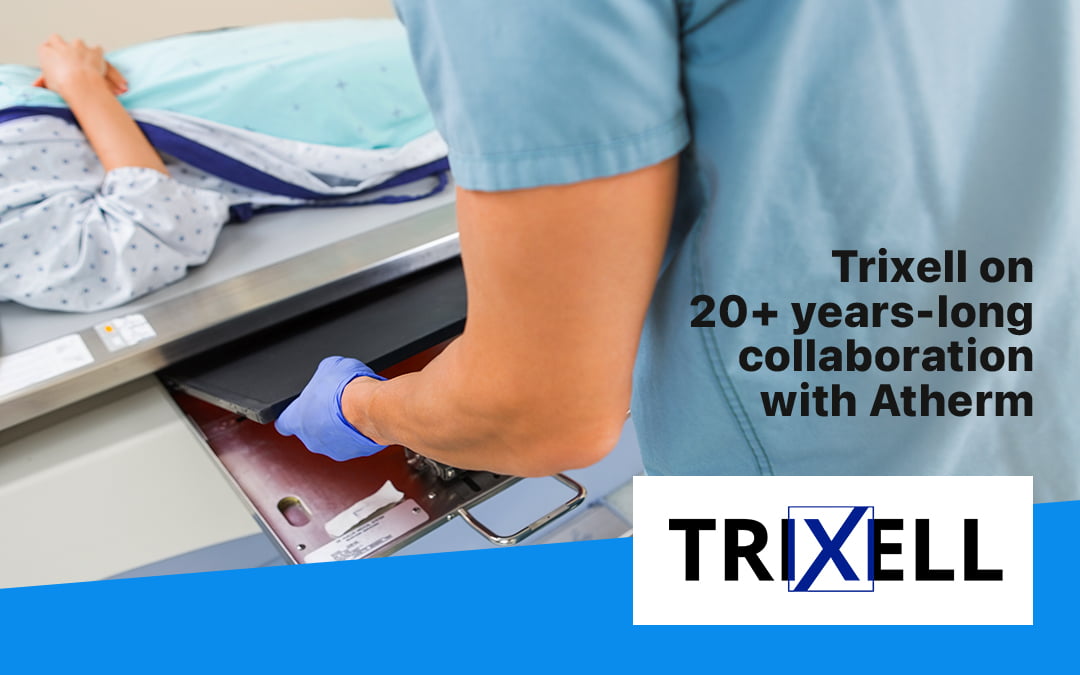2024 marks the 22nd anniversary of one of Atherm’s cooling solutions, the 4800 Cardio, a dual medical cold plate. Designed specifically for Trixell – one of the top worldwide suppliers of large-format digital detectors for health imagery applications – the 4800 Cardio is still included in some of their products. We took a moment with Trixell to review this long-standing collaboration, its driving force, and how it has evolved over the years.
Trixell specializes in flat panel digital X-ray detectors for a range of medical applications, namely radiography, fluoroscopy, and the cardiovascular sector. How did your collaboration with Atherm start back in 2002?
Trixell designs and produces detectors for medical imaging solutions co-developed with Philips and Siemens. Back in 2002, high-quality video imaging generated heat that had to be normalized and dissipated to ensure that the final images had the desired features. Consequently, we needed a tailored cooling solution. We had already tested one cold plate, but it presented issues with leaking and corrosion, so we launched a tender for a better-suited solution. Within a week, Atherm sent us a convincing thermal simulation and mechanical design. A fortnight later, they had produced a functional prototype. Atherm’s offer consisted of a stainless-steel vacuum-brazed cold plate, with watertight/non-drip quick couplings. After this very promising start, our teams entered a second phase and worked together to fine-tune the final design. Together, we produced a very satisfactory solution: the 4800 Cardio dual medical cold plate. The related contract between Trixell and Atherm was signed by the end of 2002.
This was just the first of three products that Atherm developed for Trixell. What is the underlying story? How has your collaboration evolved?
Indeed, the range of detectors using Atherms’ cold plates has progressively evolved. Two subsequent products included their cooling solutions. First, in mid-2003, the 4700 fluoroscopy detector embarked the large medical cold plate. And subsequently, the large-format 3040, developed for the interventional and surgical range was equipped in 2011 with the small medical cold plate. Today, only two of these products are still commercialized by Trixell, mainly the most recent model. The 3040 is a state-of-the-art flat panel detector for interventional radiology. It has an outstanding Pixium® Csi X-ray absorption efficiency, is adaptable for 3D imaging, and capable of following up to 60 frames per second. The Small medical cold plate it encompasses has a dissipating power of 50 to 100W, ensuring +/- 1°C temperature homogeneity over relatively small dimensions—200mm x 200mm width, with a surface flatness of 0.5mm. Due to market demand, the original 4800 Cardio remains in production, and the collaboration with Atherm continues.
How would you describe your decades-long collaboration?
Atherm is an excellent supplier. The last six years of archives reveal only three non-conformities. We really appreciate the constant quality of products, which place Atherm among our top five suppliers in terms of quality performance. Delivery timelines are also very well respected, as are overall forecasts. Over the years, Trixell and Atherm have developed a deep understanding, all discussions are fluid, requests are considered, and efforts are made to identify the best solution to respond to specific needs. Today, for example, we are engaged in a design-to-cost project around the 3040 model, working together on its next iteration. To build a long-term partners, the two parties need to share the same view about the relationship; we can say that this is the case for Atherm and Trixell. From the last 20+ years, we have plenty of good things to say about Atherm.

